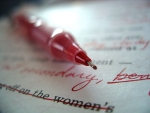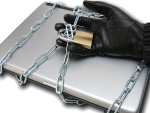 Question: Why write another article about editing?
Question: Why write another article about editing?
Answer: It is important, often skipped, and even more often shortchanged.
In the beginning, books were hand written, and it took hours to write just one page. To publish, someone had to copy the books over and over again. Each copy had a few mistakes, but, considering the amount of effort that went into the making of the book, no one complained. Except for potentates and spoiled rich nobles who demanded perfection.
Movable type was used throughout the world as early as the 10th century. About 1439, Johannes Gensfleisch zur Laden zum Gutenberg introduced the world to a method of casting and copying letter punches with quantities allowing his improved printing press to fuel the renaissance. (“Johannes Gutenberg,” Wikipedia, Retrieved 10/23/2013 http://goo.gl/zPOqGd) The Gutenberg movable type printing press made copying books easier, cheaper, and faster. However, there were still typos. In fact, the term typo is a shortening of the term typographical error which was first used in 1878. (Merriam-Webster Online Dictionary, Retrieved 10/23/2013 http://goo.gl/en1IP7)
With the printing press and mass reproduction, typos remained. Most people forgave the errors, and in fact, many book collectors use typos as a means to identify edition numbers. Many of the most famous books have many printing edition runs, each with a unique set of errors that identify not only the edition, but in some cases, which precise printing press produced the book. Specific typos are hunted because they represent the earliest editions of the book.
With the introduction of computers, people began getting really picky about typos. Minor misspellings, which would have been overlooked before, are now paraded around and used to roast the person who made the mistake. Heaven help the poor author who uses a run-on sentence or too many reflexive sentences. Even worse is the roaming comma cries of “get an editor” from people who had different English instructors who taught different “rules of comma usage.”
Nothing in the universe is perfect, yet readers demand absolute perfection for the books they read. That is until they start collecting books, at which point they demand mistakes be made so they can properly identify editions.
What should readers actually do when they see a typo or grammatical error? Write a fiery scathing personal attack review on Amazon about the idiot author who clearly needs to go back to school claiming the book has too many errors to bother listing even one issue? Of course not. Yet, some do and I ask those of you that do, to please go read up on the ‘ad hominem’ disagreement and read Paul Graham’s March 2008 essay “How to Disagree.” (http://goo.gl/YKJzC0)
Constructively, the best thing you can do when you spot errors in a book is to write a nice email message to the author (or try typing it on paper using an actual typewriter, or write a real hand written letter, you know just to do something different) listing out the typos or issues you found. I bet you’ll be pleasantly surprised by the author responding with loads of gratitude or even an explanation of why they did it on purpose. It is even likely you’ll see a new edition published (updated) with YOUR corrections and an additional acknowledgement thanking you personally for the feedback. Your name in a published book as a contributor, wouldn’t that be wonderful?
What should an author do to prevent typographical or grammatical errors? Not publish a book until it has been proven to be perfect? Of course not, not even possible. Essentially, the author should not skimp on editing. There are lots of book editing stages. Many new authors (and even some more veteran authors) mistakenly lump these stages together.
I had two professional top notch editors for my first book and sent it through them in series roughly three times each. In spite of that, I still had over a hundred and fifty typos pointed out by fans. My second book had three professional top notch editors and went through them four times each. AND, I also had ten beta readers who read the manuscript at the last stage of editorial passes, and they found hundreds of corrections.
All books before publication should be run through a professional proofreader, who is NOT one of the editors. I didn’t have this for my first book, and it showed! Great editing, good plot and character flow, logical plots, and no egregious grammatical errors but still a hundred and fifty typos. This isn’t a reflection on the editors, they did their job on the grammar, plots, language, style, and caught most of my mistakes. But, a final proofreader is really worth it. For example, my second book had a volunteer professional proofreader, and I can tell it shows. My proofreader found roughly eighty typos in the final manuscript.
As a new author, I know it isn’t likely you’ll have a qualified volunteer proofreader for your first book. Maybe not even your second book. However, you can find a professional one pretty easily, and inexpensively.
If you want to learn more about editing, I highly recommend the Rocking Self-Publishing podcast, episode #12 “Effective Editing with Harry Dewulf” (http://goo.gl/VxbXMX) that is packed with information, resources, and places to go to find what you want.
A fellow author I know and trust (Melissa Foster) just gave me a sterling recommendation for a professional proofreader named Marlene. I haven’t used her services yet myself, but I intend to try her out on an upcoming project.
[dropshadowbox align=”center” effect=”raised” width=”90%” height=”” background_color=”#c7e2e2″ border_width=”2″ border_color=”#005ed3″ ]Here is what Melissa said:Marlene does the final set of eyes proofing after your editors are done. She’s fabulous and super, super cheap – if you use her please let her know I sent you:
Has your manuscript been professionally edited, but you’d like to have one more set of eyes read through it before it’s published to catch those typos that have slipped by? Affordable, professional, fast. Contact Marlene for more info: http://bookmama2.blogspot.com/p/loading_15.html [/dropshadowbox]
So if you do use Marlene, please let her know you found her via me via Melissa.
Who do I use? My awesome editors:
- Alexis Arendt – a veteran fantasy/sci-fi “high and low level” editor – http://wordvagabond.com/
- Kitten Jackson – a top notch romance/thriller “emotional and low level” editor – http://www.kittenkjackson.com/Jackson-Editing-Services.html
- Emerald Barnes – a fabulous light “low level” editor and proofreader – http://www.emeraldbarnes.us/proofreading-services.html







